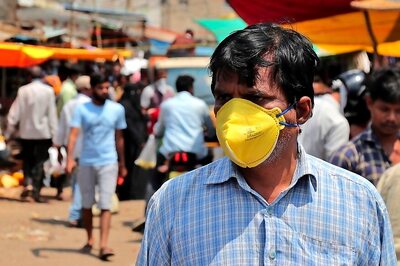
views
New Delhi: Delhi's air quality improved further on Tuesday, giving respite to people suffering due to acute pollution for a week, and the trend is likely to continue for a couple of days.
However, a senior Central Pollution Control Board (CPCB) official said the apex anti-pollution body has been keeping a close watch on the farm fires in Punjab which peaked to the season's high of 6,668 on Tuesday.
The air quality index in the national capital dropped from 365 at 9.45 am to 309 at 9 pm, according to the Central Pollution Control Board.
In the National Capital Region, Greater Noida (324), Noida (336), Ghaziabad (342), Faridabad (274) and Gurgaon (291) also recorded improvement in air quality.
An AQI between 0-50 is considered 'good', 51-100 'satisfactory', 101-200 'moderate', 201-300 'poor', 301-400 'very poor' and 401-500 'severe'. An AQI above 500 falls in the 'severe plus' category.
The India Meteorological Department said winds gusting up to 25 kmph were flushing out pollutants faster.
"There are good chances of rains in northwest India on Wednesday night and Thursday due to a western disturbance. The precipitation will cover Delhi-NCR, Jammu and Kashmir, Himachal Pradesh, Uttarakhand, Punjab, Haryana, Rajasthan and western Uttar Pradesh," head of IMD's regional weather forecasting centre of Kuldeep Srivastava, said.
He said the situation will not be similar to that of Sunday when high humidity due to light rains led to the formation of more potent secondary particles.
Secondary particles are product of complicated atmospheric reactions between primary particles such as particulate matter, sulphur dioxide and nitrogen dioxide directly emitted by stubble burning and vehicles in the presence of other factors such as sunlight and moisture.
Examples of secondary particles include sulphates, nitrates, ozone and organic aerosols.
Srivastava said visibility levels improved to 3,000-3,500 metres in the afternoon, which is considered normal.
The Ministry of Earth Sciences' air quality monitor, SAFAR, said, "The AQI is back to 'very poor' category after rapidly recovering from 'severe' largely due to faster boundary layer winds (40 kmph)."
Though Haryana and Punjab recorded 4,962 farm fires on Monday and north westerly winds, which carry smoke from stubble burning, continued to blow, Delhi air quality's "continued to recover", it said.
"It was mainly due to high transport-level wind speed which rapidly passed over Delhi without descending," SAFAR said.
Meanwhile, Punjab on Tuesday reported the season's highest farm fire count at 6,668 as farmers continued to defy a ban imposed on stubble burning, triggering fears of upending the gradual improvement in air quality registered over the past two days.
The Supreme Court on Monday ordered an immediate and complete stop to stubble burning in Punjab, Haryana and Uttar Pradesh blamed for 46 per cent of the pollution in Delhi-National Capital Region(NCR).
According to satellite data collected by Punjab Remote-Sensing Centre, Sangrur and Bathinda were the worst-affected districts with the highest number of farm fire incidents of 1,007 and 945 on a single day, respectively.
Between September 23 and November 5, Punjab reported 37,935 farm fires, which was almost 40 per cent higher than stubble burning incidents in the corresponding period last year.
The Delhi government has repeatedly blamed stubble burning for the episodes of apocalyptic smog in Delhi every year.
However, Prof. MS Swaminathan, the father of Green Revolution, has objected to people blaming farmers for the smog and high levels of pollution in Delhi-NCR.
In a series of tweets on Monday he said, "I suggest that the Delhi, Haryana and UP govts put up Rice BioParks where farmers can convert stubble into income and employment. We should stop blaming farmers since it will take us nowhere. Instead we should propose methods which are economically & ecologically desirable."



















Comments
0 comment